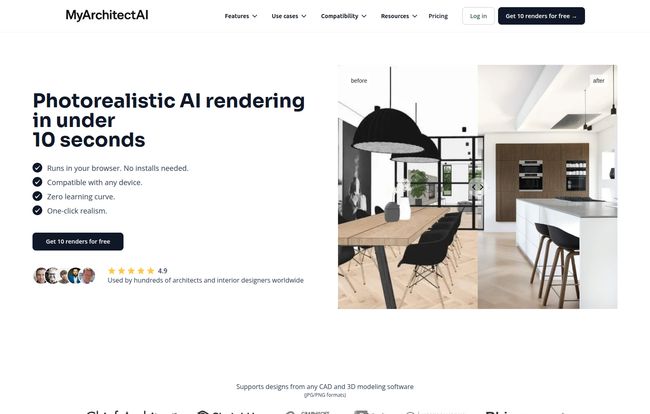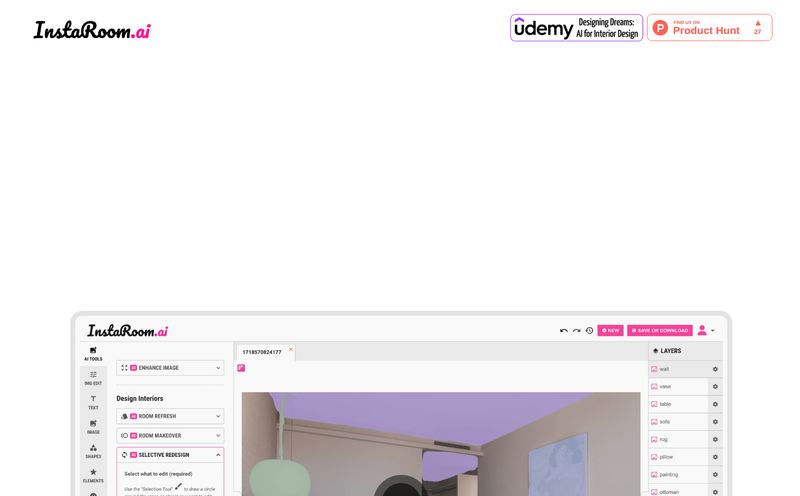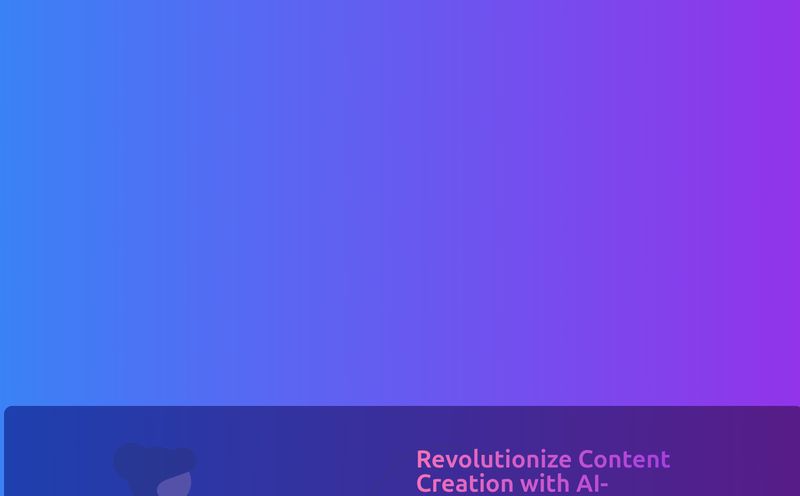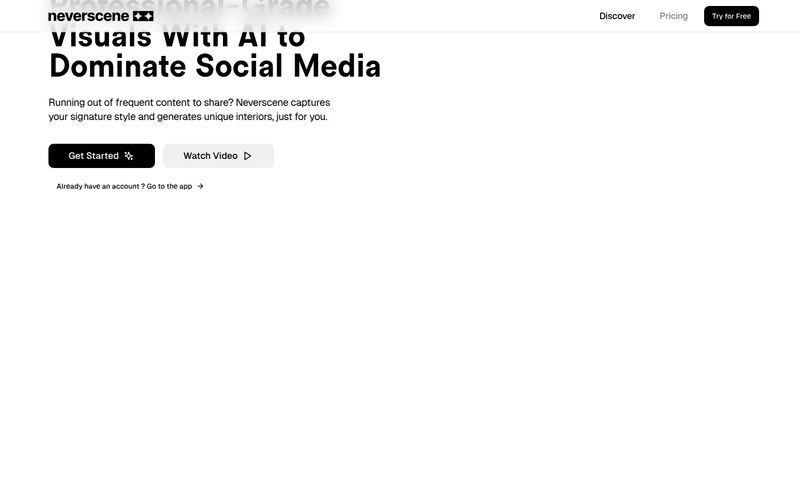If you’re an architect or designer, you know the pain. That special kind of purgatory that exists between finishing a 3D model and actually having a beautiful image to show your client. It’s the land of whirring computer fans, endless progress bars, and the silent prayer that your machine doesn’t crash four hours into an eight-hour render. We’ve all been there. I’ve personally lost entire evenings to V-Ray, tweaking settings, and waiting for those little buckets to fill in. Fun times.
So, when a tool like MyArchitectAI pops up on my radar, claiming to produce “photorealistic AI rendering in under 10 seconds,” my inner cynic immediately scoffs. Ten seconds? My computer takes longer than that to open Photoshop. But the professional in me, the one who’s always chasing efficiency and better ways to visualize ideas, was intrigued. Another AI tool promising to change everything? Okay, I’ll bite.
I’ve spent some serious time with it, fed it some of my old SketchUp models, and I’m ready to give you the no-fluff, real-talk review. Is this the magic bullet we’ve been waiting for, or just another shiny object?
So What Is MyArchitectAI, Exactly?
Think of it like this: you have your 3D model in SketchUp, Archicad, Revit, whatever you use. It’s structurally sound, but it looks… well, it looks like a CAD model. Gray, lifeless, and about as inspiring as a concrete block. Normally, you’d export this to a complex rendering program, spend hours setting up lighting, textures, and environments, and then render it.
MyArchitectAI throws that whole process out the window. It’s a browser-based tool. You don’t install anything. You take a screenshot or a simple export (a JPG or PNG) of your model, upload it, type a brief description of the vibe you’re going for—like “modern kitchen, soft natural lighting”—and hit go. In about the time it takes to read this sentence, it gives you back a fully rendered, atmospheric image.
The founders have a great line for it: they aim for 90% of the result of complex non-AI rendering software with just 10% of the effort and cost. And honestly? That’s a pretty accurate way to put it. It’s not about replacing the final, ultra-high-def marketing shot. It’s about revolutionizing the process of getting there.

Visit MyArchitectAI
#
The Core Features That Actually Matter
A lot of software boasts a million features you’ll never use. I found that MyArchitectAI focuses on a few things and does them surprisingly well. It’s not a bloated, do-everything monstrosity; it's more like a specialized, sharp tool.
From Model to Masterpiece in a Flash
The main event is the AI rendering engine. The most impressive part for me is its respect for your original geometry. I’ve played with other AI image tools where you give it a sketch and it gives you back a beautiful, but completely different, building. MyArchitectAI is different. It understands the shapes, the walls, the furniture placement from your original CAD image and keeps it intact. It then applies realistic lighting, materials, and textures based on your text prompt. The result feels like your design, just brought to life. It's an important distinction.
#
Playing Interior Decorator with AI Style Transfer
This feature is just plain fun, but also incredibly useful. Got a reference image you love? A photo of a hotel lobby in Bali or a minimalist Scandinavian living room from Pinterest? You can upload that reference image along with your model. The AI will then “transfer” the style—the color palette, the mood, the materials—onto your design. It's a fantastic way to quickly explore different aesthetic directions with a client without having to manually re-texture your entire model. It turns a conversation that could take days of remodeling into one that takes minutes.
The Magic Eraser for Renders
Okay, so you’ve got your render, but the client hates the armchair. Or you decide the wooden floor should be concrete. In the old world, that meant going back to the model and re-rendering everything. Ugh. The AI Render Editing tool lets you just select an area of the finished image and tell the AI what to change. “Change this chair to a leather sofa” or “remove this vase.” It regenerates only that little piece, saving a ton of time. It also has an AI Enhancer that can take a grainy or low-resolution render and clean it up, adding detail and sharpening textures. It's not perfect, but for quick fixes, it's a lifesaver.
Let's Talk Speed and Why It Changes Everything
I can’t overstate the importance of the speed. Ten seconds. It feels almost absurd. The workflow transformation is huge. Instead of presenting one or two painstakingly prepared options to a client, you can sit with them and generate variations in real-time. “What if we tried a darker wood for the cabinets?” Click. “How would it look with more morning light?” Click.
This turns the design presentation from a static show-and-tell into a dynamic, collaborative workshop. It closes the feedback loop instantly. I threw together a quick comparison based on their site and my own experience:
| Metric | MyArchitectAI | Traditional Software (Lumion/V-Ray) | Outsourcing to a Pro |
|---|---|---|---|
| Time to Get an Image | ~10 seconds | Hours, sometimes days | Days, sometimes weeks |
| Cost | Starts at Free, $29/mo for Pro | $500 - $3000+ per year | $250+ per single image |
| Learning Curve | Basically none | Weeks to months | N/A |
| Hardware Needed | A web browser | A beast of a computer | N/A |
Seeing it laid out like that... it’s pretty compelling. You’re trading a bit of that final 10% of polished perfection for an insane gain in speed and flexibility.
My Honest Take: The Good, The Bad, and The AI
No tool is perfect. Let's get into the nitty-gritty. After all the hype, here's what I genuinely think.
What’s great is the accessibility. The fact that it runs on any device with a browser is a game-changer. No more being chained to a single, high-powered desktop. The zero learning curve claim is also pretty much true. If you can upload a photo and type a sentence, you can use this. And I have to mention the support—the website mentions getting help directly from the founders, and that small-company touch is definately a plus in a world of faceless support tickets.
However, it's not a one-stop-shop for every rendering need. As they say themselves, it's about getting you 90% of the way there. If you need a flawless, 8K render for a magazine cover, you'll probably still need to turn to your trusty traditional software for that final, meticulous polish. It also can occasionally get small details a little fuzzy or “AI-ish,” though it’s getting better. And, of course, the best features like unlimited renders and commercial use are on the paid plan.
#
Who Is MyArchitectAI Actually For?
So, who should drop what they're doing and try this? In my opinion, the sweet spot for MyArchitectAI is massive.
It's for the solo architect or small firm that needs to produce beautiful concepts quickly without a dedicated visualization team. It's for the interior designer who wants to show clients multiple style options on the fly. It's a fantastic tool for students who need to build a portfolio without access to expensive software licenses or render farms. Even real estate agents could use it to quickly mock up potential renovations for a listing.
Who is it not for? Probably the large, international firm that has a whole department of visualization artists dedicated to creating hyper-realistic marketing collateral for multi-million dollar projects. They'll still need their established, high-fidelity pipelines. But for everyone else? It’s at least worth a look.
The All-Important Question: What's the Price?
This is where things get really interesting. MyArchitectAI has a pretty simple pricing structure, which I appreciate.
- Free Plan: You get 10 renders a month. This is perfect for just trying it out and seeing if it fits your workflow. The downloads are standard quality and it’s for private use only, but it gives you full access to the core engines. No-brainer to start here.
- Pro Plan ($29/month): This is the one for professionals. You get unlimited renders, a commercial usage license, and high-quality 4k downloads. You also get priority support and even the option for 1-on-1 training sessions with one of the co-founders, which is kind of wild. There’s no long-term contract, you can cancel anytime.
- Pro Annual Plan ($249/year): Same as the Pro plan, but you get a pretty hefty discount for paying upfront (works out to about $20.75/month). If you know you're going to use it regularly, this is the best value.
Honestly, for what it does, $29 a month is incredibly reasonable. That's less than a few fancy coffees. When you compare it to the cost of a single outsourced render, it pays for itself with one project.
#
Frequently Asked Questions
I had some of these same questions, so here are the quick answers I dug up from their site.
Do I need any 3D modeling skills to use this?
Nope. You just need an image to start with. If you have a sketch or a CAD model, great. If not, you could probably even start with a photo and modify it. The AI does the heavy lifting of modeling and texturing.
Do I need a super powerful computer?
Absolutely not. Since it all happens in the cloud on their servers, you can run it on a MacBook Air, a Chromebook, or even a tablet. Your computer's hardware doesn't matter at all.
How fast is it really?
They claim 99% of renders are done in under 10 seconds. In my testing, this held up. It's shockingly fast.
What kind of files can I upload?
It currently supports standard image formats: JPEG, PNG, and GIF. So you can just export a simple view from your CAD program.
Who owns the renders I create?
You do. 100%. If you're on the Pro plan, you have a full commercial license to use them however you want.
Is there a refund policy?
Yes, they seem pretty fair about it. If you're not happy, you can contact them for a refund, as long as you've created fewer than 10 renders on your paid plan.
Final Thoughts: Is MyArchitectAI Worth Your Time?
So, back to the big question. Is it a gimmick or a game-changer? My verdict: it's a legitimate game-changer for a specific, and very large, part of the design process—the beginning. The messy, creative, iterative part.
It won’t replace the artistry and technical skill of a high-end visualization specialist creating a masterpiece. But that's not the point. It’s a different tool for a different job. It’s a tool for speed, for iteration, for collaboration. It’s a tool that lets you stay in the creative flow instead of getting bogged down by technical hurdles.
For me, the value is clear. It’s a bridge between the sterile world of CAD and the vibrant, emotional world of a finished design. And it lets you cross that bridge in ten seconds. In this industry, that’s nothing short of revolutionary. I’d say give the free plan a spin. You've got nothing to lose but a few progress bars.



